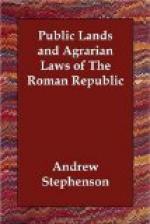We have now passed in review the agrarian laws proposed and, in some cases, enacted between the years 485 and 376, i.e. between the lex Cassia and the lex Licinia, which the greater part of the historians have neglected. We have now come to the propositions of that illustrious plebeian whose laws, whose character, and whose object have been so diversely appreciated by all those persons who have studied in any way the constitutional history of Rome. We wish to enter into a detailed examination of the lex Licinia, but before so doing have deemed it expedient to thus pass in review the agrarian agitations. The result of this work has, we trust, been a better understanding of the real tendency, the true purpose, of the law which is now to absorb our attention. It was no innovation, as some writers of the day assert, but in reality confined itself to the well beaten track of its predecessors, striving only to make their attainments more general, more substantial and more complete.
[Footnote 1: “Solicitati, eo anno, sunt dulcedine agrariae legis animi plebis,. . . vana lex vanique legis auctores.” Livy, II, 42.]
[Footnote 2: Dionysius, VIII, 606, 607.]
[Footnote 3: Livy, loc. cit.: Dionysius, loc. cit.]
[Footnote 4: Dionys., VIII, 554.]
[Footnote 5: Dionys., VIII, 555.]
[Footnote 6: Val. Max., Fg. of Bk. X: “Spurii, patre incerto geniti.”]
[Footnote 7: Livy, loc. cit.; Dionys., loc. cit.]
[Footnote 8: Dionys., IX, 558; Livy, II, 43.]
[Footnote 9: Dionys., IX, 559-560: “[Greek: tous kategontos taen choran taen demosian.” . . . “Kai Sikilios oudenos eti kurios aen.]".]
[Footnote 10: Livy, loc. cit.]
[Footnote 11: Livy, II, 44: “Et unum vel adversus omnes satis esse ... quatuorque tribunorum adversus unum.”]
[Footnote 12: Dionys., IX, 562.]
[Footnote 13: Livy, loc. cit.; Dionys., loc. cit.]
[Footnote 14: Livy, II, 48: “Captivum agrum plebi, quam maxime aequaliter darent. Verum esse habere eos quorum sanguine ac sudore partus sit. Aspernati Patres sunt.”]
[Footnote 15: Livy, II, 61, 63, 64.]
[Footnote 16: Dionys., IX, 606, 607; Livy, III, 1. The authorities are somewhat conflicting at this point, and I have followed the account of Dionysius.]
[Footnote 17: Schwegler, Roemische Geschichte, II, 484; Dionys., X, 31, p. 657, 43.]




